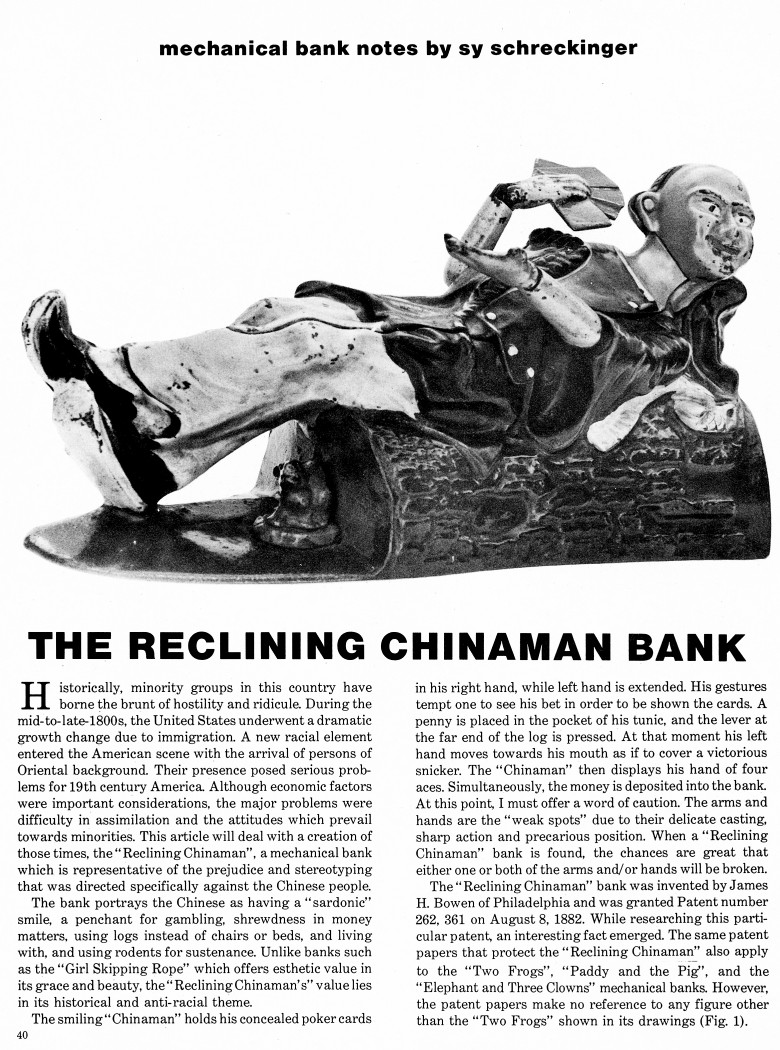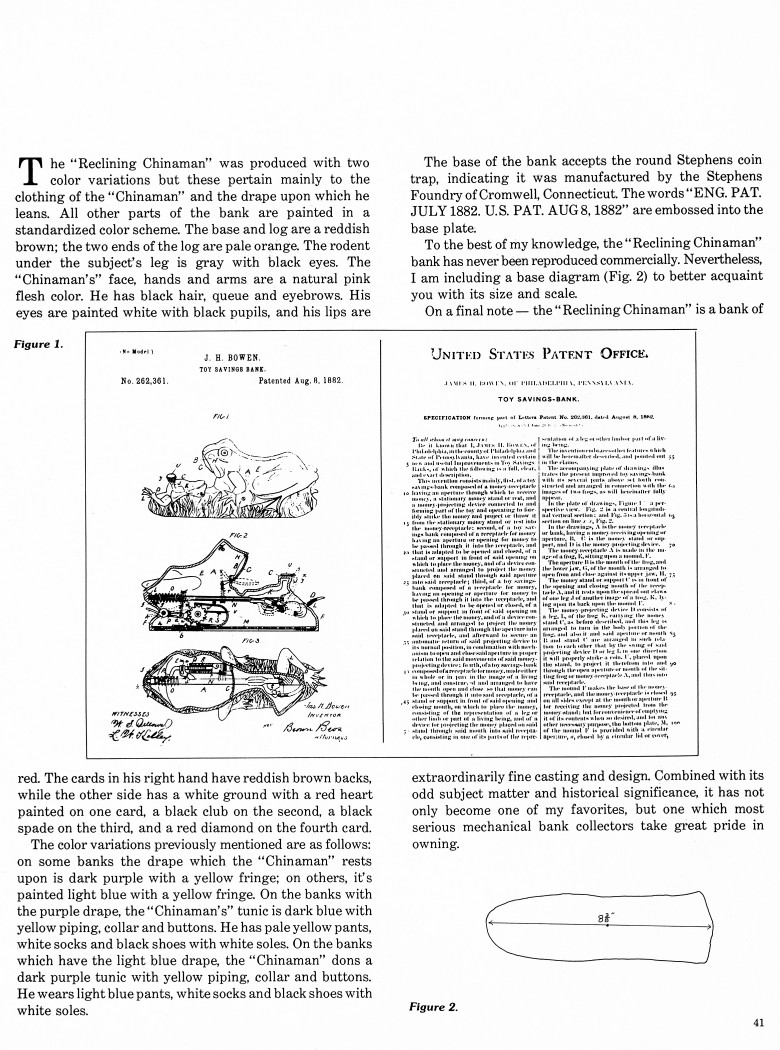|
The Reclining Chinaman
Bank
by Sy Schreckinger – ANTIQUE TOY WORLD Magazine – April, 1983
Historically, minority groups in
this country have borne the brunt of hostility and ridicule. During the
mid-to-late-1800s, the United States underwent a dramatic growth change
due to immigration. A new racial element entered the American scene with
the arrival of persons of Oriental background. Their presence posed
serious problems for 19th century America. Although economic factors were
important considerations, the major problems were difficulty in
assimilation and the attitudes which prevail towards minorities. This
article will deal with a creation of those times, the "Reclining
Chinaman", a mechanical bank which is representative of the prejudice and
stereotyping that was directed specifically against the Chinese people.
The bank portrays the Chinese as having a "sardonic" smile, a
penchant for gambling, shrewdness in money matters, using logs instead of
chairs or beds, and living with, and using rodents for sustenance. Unlike
banks such as the" Girl Skipping Rope" which offers esthetic value in its
grace and beauty, the" Reclining Chinaman's" value lies in its historical
and anti-racial theme.
The smiling" Chinaman" holds his concealed poker cards in his right
hand, while left hand is extended. His gestures tempt one to see his bet
in order to be shown the cards. A penny is placed in the pocket of his
tunic, and the lever at the far end of the log is pressed. At that moment
his left hand moves towards his mouth as if to cover a victorious snicker.
The "Chinaman" then displays his hand of four aces. Simultaneously, the
money is deposited into the bank. At this point, I must offer a word of
caution. The arms and hands are the "weak spots" due to their delicate
casting, sharp action and precarious position. When a "Reclining Chinaman"
bank is found, the chances are great that either one or both of the arms
and/or hands will be broken.
The "Reclining Chinaman" bank was invented by James H. Bowen of
Philadelphia and was granted Patent number
262,361 on August 8, 1882.
While researching this particular patent, an interesting fact emerged. The
same patent papers that protect the "Reclining Chinaman" also apply to the
"Two Frogs", "Paddy and the Pig", and the "Elephant and Three Clowns"
mechanical banks. However, the patent papers make no reference to any
figure other than the "Two Frogs" shown in its drawings (Fig. 1).
The "Reclining Chinaman" was produced with two color variations but
these pertain mainly to the clothing of the "Chinaman" and the drape upon
which he leans. All other parts of the bank are painted in a standardized
color scheme. The base and log area reddish brown; the two ends of the log
are pale orange. The rodent under the subject's leg is gray with black
eyes. The "Chinaman's" face, hands and arms are a natural pink flesh
color. He has black hair, queue and eyebrows. His eyes are painted white
with black pupils, and his lips are red. The cards in his right hand have
reddish brown backs, while the other side has a white ground with a red
heart painted on one card, a black club on the second, a black spade on
the third, and a red diamond on the fourth card.
The color variations previously mentioned are as follows: on some
banks the drape which the "Chinaman" rests upon is dark purple with a
yellow fringe; on others, it's painted light blue with a yellow fringe. On
the banks with the purple drape, the "Chinaman's" tunic is dark blue with
yellow piping, collar and buttons. He has pale yellow pants, white socks
and black shoes with white soles. On the banks which have the light blue
drape, the "Chinaman" dons a dark purple tunic with yellow piping, collar
and buttons. He wears light blue pants, white socks and black shoes with
white soles.
The base of the bank accepts the round Stephens coin trap, indicating
it was manufactured by the Stephens Foundry of Cromwell, Connecticut. The
words "ENG. PAT. JULY 1882. U.S. PAT. AUG 8, 1882" are embossed into the
base plate.
To the best of my knowledge, the" Reclining Chinaman" bank has never
been reproduced commercially. Nevertheless, I am including a base diagram
(Fig. 2) to better acquaint you with its size and scale.
On a final note — the "Reclining Chinaman" is a bank of
extraordinarily fine casting and design. Combined with its odd subject
matter and historical significance it has not only become one of my
favorites, but one which most serious mechanical bank collectors take
great pride in owning.
|


